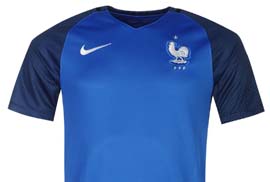
With the final phase of the European Championship, and after seeing the chemical composition of football balls, this is the ideal moment to continue with this section and to talk about the chemical components of other of the European Championship focus: shirts.
30 june 2016
Before the usage of polymers in clothes manufacturing, shirts were made of cotton and wool. These materials, obviously, were too uncomfortable for practising sports; they were excessively hot and absorbed much more sweat.
The use of polyester in football uniforms started to be the the dominant note in the clubs during the 90s. In clothing, polyesters have a great advantage over the traditional cotton fibres, since they absorb much less water. While cotton retains 7% of its weight in water, polyester only absorbs around 0,4% of its weights, which favours the comfort of football players during the games. Also, it generates a better transpiration due to its composition, since the sweat evaporation in this type of shirts is faster that in cotton shirts, and also they are longer-lasting and do not crease.
While some shirts are completely made of polyester, others have different components. For instance, elastin, a polymer commonly known las Lycra. In order to produce it, the prepolymer is formed first with glycol and diisocyanate compounds through a reaction of a 1:2 proportion. After that, through another reaction with diamine, it is produced polymer liquid of elastine, which will produce the final material, the elastane. This material is less breathable, but it has the capacity of withstanding distensions of 600% in its length, which is very useful in contact sports in order to avoid their breakage and to return them to their original shape after every dangerous action.
A last type of polymer used in the manufacture of sport shirts is the polyurethane, also used in modern balls. It is very common to find them in the adhesive elements of shirts, such as the numbers or the sponsors, although in some occasions are also find in fabrics, since it is a good thermal insulator and is waterproof.
Obviously, even though we have focused on football shirts in this post, polyesters are find in many clothing and other objects, since they are very versatile materials with numerous usages, beyond the production of fabrics.











